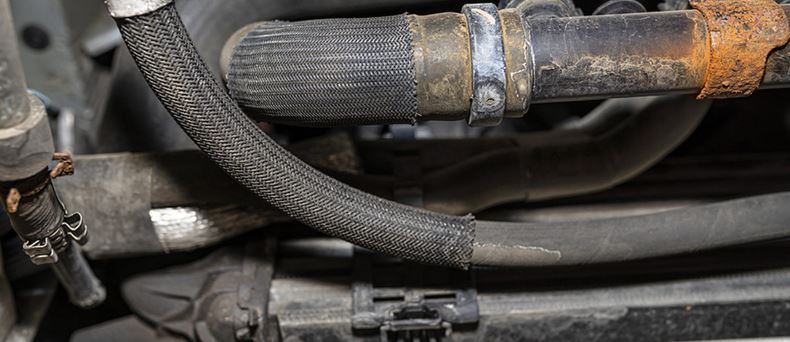As a vehicle owner, you are bound to have several experiences while keeping your car in good working condition. For example, if the lower radiator in your car suddenly starts blowing cold air instead of hot, you may misinterpret this as a severe car problem and become concerned.
Why is My Top Radiator Hose Hot and Bottom Cold
The reason this so is that, when it comes down to classifying “normal car operations,” the lower radiator hose should always be colder than the higher radiator hose. Why? Because the top line helps to channel hot coolant from the engine to the radiator, while the lower hose carries cooled coolant from the radiator back into the engine.
Your car thermostat manages the amount of cold coolant that enters the engine via the lower radiator hose from the radiator. Therefore, on scorching days, the lower radiator hose should be cold, or at least warm.
Note: In summary, this implies is that your radiator is working correctly: the hot coolant leaving the engine via the upper radiator hose is successfully cooled. Thus, try not to worry too much when you notice this in your vehicle.
Related Article:
How to Flush Radiator With Vinegar & Baking Soda
What does it mean when the top radiator hose is cold?
You need to understand that the top hose does not get hot until the thermostat opens. This, in turn, allows the hot water to flow into the radiator. Therefore, the thermostat will not fail as a result of a flush. Therefore, we can conclude that if the top hose is cold, the thermostat isn’t open.
The following factors affect the time of the opening of the thermostat:
- Range of the thermostat
- Ambient temperature
- The load on your engine
- The temperature of the coolant
- a burden on the engine
Make sure the system is coolant-filled by draining out all the air. Try putting the system to the test in a congested area with the air conditioner on full blast. You’ll be OK if it passes this test. The thermostat is often located at the top radiator pipe. However, this is not always the case. After the thermostat is turned on, the top hose becomes hot in either case.
Keynote: If the top hose becomes hot even before the engine has fully revved, the thermostat is not correctly shutting or possibly always open. It suggests the thermostat is blocked if it doesn’t become hot at all. The thermostat should indeed be replaced as soon as possible in both circumstances.
What does it mean when the top radiator hose is hot?
When the top radiator hose is hot, it simply means that the thermostat is open and hot water is flowing through it. So, in summary, if the top hose is hot, it is working well within its functions.
To take better care of your car, here are some signs to watch out for to know if your top radiator hose is faulty; they include;
- Overheating of the engine
- The coolant level is low.
- The radiator hose has collapsed.
- The radiator hose has been ruptured.
- The coolant is leaking. If you see green fluid underneath your car, it’s likely seeping coolant.
However, if it gets hot too quickly when the vehicle comes on, it could also indicate that your thermostat is not open or, at the very least, faulty.
Why is my bottom radiator hose hot?
The bottom of the radiator is connected to the water pump, which circulates the coolant throughout the system through the lower radiator hose. Hose clamps secure both hoses to their respective ports. Therefore, if the lower radiator hose is hot, there is probably an have a faulty thermostat.
Core characteristics of the lower radiator hose:
- It functions as a suction hose.
- On the interior of the hose, there is a wrapped wire spring to keep it from collapsing.
- It links to the engine’s pump and the bottom of the radiator.
While some heat is acceptable in the bottom hose, it should be colder than the top hose. On the other hand, the automobile might overheat or run hot if the thermostat was jammed closed or if the water pump was broken.
Hot coolant from the engine enters the radiator through the top radiator hose. It cools as it passes through the radiator. When it reaches the bottom, it exits the radiator via the lower hose and returns to the engine, where the cycle begins all over again.
The upper and lower hoses work together as a duo. One inhales heated air, while the other exhales cool air. When both hoses are hot, there’s a problem that has to be addressed.
Why is my top radiator hose hot and bottom cold?
It is perfectly natural if you notice that your radiator hose is hot at the top and cool at the bottom. There is no need to worry, especially if your vehicle isn’t overheating. Your radiator is simply doing its job.
Just like breathing in and breathing out for humans occur, your radiator performs the funtion of taking in hot air and giving out cool air.
Hoses transfer coolant into and out of the radiator. There are two radiator hoses: one for the upper radiator and one for the lower radiator. Even though they both deliver coolant, they are vastly different. When you put them side by side, you’ll see that they have varying lengths and forms. They also do a variety of tasks.
Why is my top radiator hose hot and bottom cold BMW x5?
As long as your temperature gauge shows normal, this appears to be expected. In addition, BMWs are noted for having large radiators and large coolant capacities.
The typical path for cooling water is out the top, past the engine’s thermostat, and down through the radiator, so you should notice a significant temperature difference between the top hose and the radiator outlet or bottom hose indicating that the radiator is absorbing heat from the coolant. Which, by the way, isn’t a cause for concern.
Note: The thermostat alone will not open unless the car is in the chilly ambient temperature. Coolant will flow via the top hose, the radiator, and out the bottom hose once it has opened up. Without airflow via the fins, the radiator isn’t very effective at all. So, if the fan weren’t on, I’d anticipate the top hose to get quite hot, as well as the bottom hose.
What can you do?
Check the rad input and rad output using some skin temperature readers. If the rad intake warms up, the rad exit should as well. However, suppose the outflow remains cold with no temperature change. In that case, you may have a leak or an obstruction where the coolant is driving itself back through the overflow pipe used to remove air from the engine if the rad cannot support a rad cap, rather than out the outflow.
Should top and bottom radiator hoses be hot?
No, it is not a norm for both radiator hoses to be hot at the same time.
Have you noticed that both radiator hoses are warm? This is because the core receives hot coolant if both radiator lines are heated. Look under the glove box on the heater case to see if the temperature blend door actuator is functioning the temperature blend door. Replace the actuator and check the heater output if the actuator is not moving.
Should radiator hoses be hard when hot?
A good radiator hose should feel firm but not hard, regardless of the temperature. A damaged radiator hose is rigid, spongy, or soft to the touch. Rather than the entire hose is soft, you might find a single soft spot. Replace any hose that is too soft or has a soft spot.
Due to a significant faulty head gasket or cracks, hard hoses can indicate cylinder pressure entering the cooling system. Although the hoses are supposed to harden as the vehicle warms up, you ought to be able to press them, and even more so after a quick ride in which the car surpassed operating temperature.
Lower radiator hose cold overheating
The most likely culprit is a closed thermostat.
If your automobile is overheating while also failing to heat the lower coolant line, you most likely have a thermostat problem that requires replacement.
Some reasons for overheating in your car engine:
- Radiator hoses have worn out
- A broken radiator
- A malfunctioning radiator fan
- The coolant channels have become clogged.
- A broken water pump
When an automobile overheats, it indicates that the engine cooling system is malfunctioning. The engine cooling system’s job is to maintain the engine running at a fixed temperature.
The engine cannot work effectively if the engine’s temperature becomes too hot or too cold, and excessively hot or cold temperatures might harm engine components.
Upper radiator hose not getting hot
The most likely cause is that your thermostat is clogged if your top radiator hose does not become hot at all. The thermostat should be replaced as soon as possible in both circumstances.
You should be seeing a warning light for overheating at this time. You’re probably running out of coolant. Open your radiator cap when the engine cools down and only when the engine cools down. There will most likely be no coolant in it.
It should be noted that it might be partially stuck open, partially jammed closed, or entirely stuck open. Which would result in a variety of symptoms? In addition, when the door is fully open, the engine runs excessively cold, reducing performance and gas efficiency.
Finally, make sure the radiator recovery reservoir cap is secure. The radiator hoses may frequently feel soft rather than turgid if it isn’t keeping pressure. Why are BMW Oil Changes so Expensive?
Hi dear, I am Gift Dennis I have been working as a Radiographer for over 8 years, but I switch my profession to what I love which is auto body part repairs and I recently got my automotive diploma last August 2020 as an auto-body repair technician. I love fitness and everything about cars, so here is where I share my expertise and experiences with those who wish to hear about them.


